

Anat Goodman
Mother, wife, teacher, student, blogger, Web 2.0, Advocate for technology in classroom, Teaching English in the Web Era, life long learner..
Heli connecting ideas » Blog Archive » Research about MOOC pedagogy. Rita Kop, Helene Fournier and Sui Fai John Mak have published an article “A Pedagogy of Abundance or a Pedagogy to Support Human Beings?
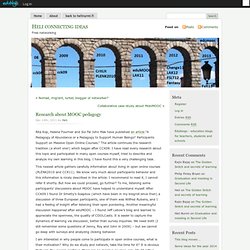
Participants Support on Massive Open Online Courses.” The article continues the research tradition (a short one!) Which began after CCK08. Connectivism. Open Education. Anatgoodman - home. Twitter. Anat Goodman's Page. Research publications on Massive Open Online Courses and Personal Learning Environments. People interested in Massive Open Online Courses will probably be aware of the research by Helene Fournier and me on Personal Learning Environments and MOOCs.
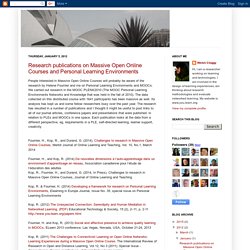
We carried out research in the MOOC PLENK2010 (The MOOC Personal Learning Environments Networks and Knowledge that was held in the fall of 2010). The data collected on this distributed course with 1641 participants has been massive as well. Its analysis has kept us and some fellow researchers busy over the past year. The research has resulted in a number of publications and I thought it might be useful to post links to all of our journal articles, conference papers and presentations that were published in relation to PLEs and MOOCs in one space. Each publication looks at the data from a different perspective, eg, requirements in a PLE, self-directed learning, learner support, creativity.
Kop, R. (2012) The Unexpected Connection: Serendipity and Human Mediation in Networked Learning. Anat Goodman Web 2. אוניברסיטת חיפה - לבלוט בנוף האקדמי. Anat Goodman @ Haifa University. Technologies in Education, University of Haifa. Wikiedtech.haifa.ac.il. Networked Student. Connectivism. CCK09: Connectivism and Constructivism. Magnetix This was written as a comment on April Hayman’s post comparing Legos and Magnetix as metaphors for constructivism and connectivism.
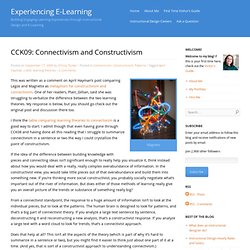
One of her readers, Plain_Gillian, said she was struggling to verbalize the difference between the two learning theories. My response is below, but you should go check out the original post and discussion there too. I think the table comparing learning theories to connectivism is a good way to start. I admit though that even having gone through CCK08 and having done all this reading that I struggle to summarize connectivism in a sentence or two the way I could crystallize the point of constructivism. If the idea of the difference between building knowledge with pieces and connecting ideas isn’t significant enough to really help you visualize it, think instead about how you would deal with a really, really complex overabundance of information.
Does that help at all? If you’re having trouble verbalizing it, then go with some other medium makes sense. Interview with George Siemens - LE@D, Universidade Aberta. Connective Learning: Challenges for Learners, Teachers, and Educational Institutions. By Claude Almansi Editor, Accessibility Issues ETCJ Associate Administrator The International Review of Research in Open and Distance Learning (IRRODL) has dedicated a special issue to “Connectivism: Design and Delivery of Social Networked Learning” (March 2011), edited by George Siemens (Athabasca University, Canada) and Grainne Canole (Open University, UK).
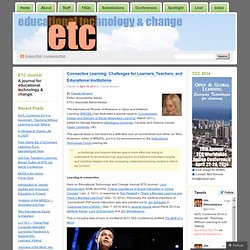
This special issue is not meant as a definitive sum on connectivism but rather, as Terry Anderson, editor of IRRODL, put it in his announcement on the Instructional Technology Forum mailing list: … a challenge and request that we spend more effort into trying to understand if connectivism has approaches and delivers important insights and practical designs into the increasing networked learning context in which we function.
Learning is connective This is not just a bias of ours. Almost half a millennium earlier, Pierre Eyquem, seigneur de Montaigne, decided that his baby son Michel should learn Latin. Social Networked Learning. Connectivism. A (more or less) complete list of my presentations.
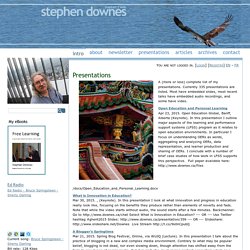
Currently 335 presentations are listed. Most have embedded slides, most recent talks have embedded audio recordings, and some have video. Open Education and Personal Learning Apr 23, 2015. Open Education Global, Banff, Alberta (Keynote). Anat Goodman @ Haifa University » PEER Reviewed Aricle and Twitter. What Does Connectivism Mean for Education? The theory of Connectivism provides new insight into what it means to facilitate learning in the 21st Century.
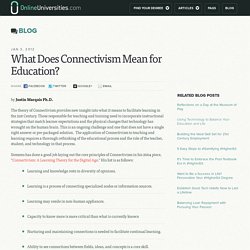
Those responsible for teaching and training need to incorporate instructional strategies that match learner expectations and the physical changes that technology has wrought on the human brain. Heli connecting ideas » Blog Archive » Collaborative case-study about MobiMOOC. I have to continue with the same IRRODL journal (see my former post).
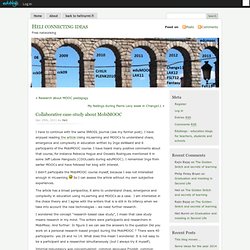
I have enjoyed reading the article Using mLearning and MOOCs to understand chaos, emergence and complexity in education written by Inge deWaard and 6 participants of the MobiMOOC course. I have heard many positive comments about that course, for instance Rebecca Hogue and Osvaldo Rodrigues mentioned it in some Jeff Lebow Hangouts (COOLcasts during eduMOOC). Heli Nurmi (@helinur) sur Twitter. נדבכים עיקריים בלמידה כיום עפ"י ג'ורג סימנס. תיאורית ה- Connectivism: תיאורית הידע הדינאמי המקושר בין אנשים. התיאוריה של קישוריות אנושית בחינוך מתוקשב שפותחה על ידי החוקר הקנדי George Siemens זוכה לאחרונה להתעניינות רבה והוא מוזמן לכנסים בינלאומיים באירופה ובאוסטרליה כדי לשאת את דבריו ולהציג את התפיסה של Connectivism.
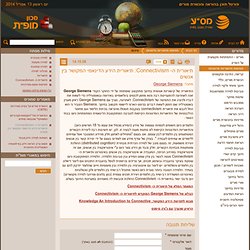
לאחרונה, נערך עם George Siemens ראיון מעניין באוסטרליה שם הוזמן לשאת דברים בכינוס הארצי ליישומי תקשוב בחינוך. Twitter. Videos connectivism. Learning Theory. Open Education. TEDxNYED - David Wiley - 03/06/10. David A. Wiley. David Wiley, October 2012 Wiley's work on open content, open educational resources, and informal online learning communities has been reported in many international outlets, including The New York Times,[8] The Hindu,[9] MIT Technology Review,[10] and WIRED.[11] Wiley is also a member of the Advisory Committee of University of the People.[12]

Twitter. About — Connectivism. Description of Connectivism Connectivism is a learning theory for the digital age.
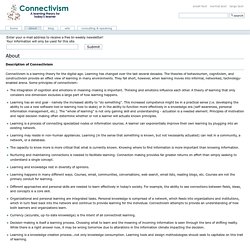
Learning has changed over the last several decades. The theories of behaviourism, cognitivism, and constructivism provide an effect view of learning in many environments. They fall short, however, when learning moves into informal, networked, technology-enabled arena. Technologically Externalized Knowledge and Learning « Connectivism. Let’s take a step back and consider how well we are using learning technology in contrast with what is possible given advances over the last decade. Ideologies influence design, then design constrains future options. We don’t have to look very far to see examples of this simple rule: classrooms, design of organizational work activities, politics, and the operation of financial markets. What we create to survive during one era serves as neurosis for another. Twitter. News: Killing Peer Review. When a cadre of international scientific research powerhouses announced last month that they were teaming up to create a top-shelf, peer-reviewed free journal in the medical and life sciences fields, some called it a "triumph of open access" — proof that the tide was turning in favor of a once-radical movement aimed at cutting through the traditional oligarchies and turning scholarly publishing on its head.
But to Joe Pickrell, a doctoral student in biology at the University of Chicago, the idea was not groundbreaking enough. It will not do merely to lower the barriers to viewing scholarly articles, he thought; academe must lower the barriers to reviewing them. As one might expect from an advocate of modern publishing, Pickrell took to the blogosphere. "Left unanswered … is a more fundamental question: why do we publish scientific articles in peer-reviewed journals to begin with? " Pickrell went on to describe, in general detail, the features this journal-killing app would require. Technologically Externalized Knowledge and Learning « Connectivism.
Wendy Drexler Ed.S - Super Slogan. Teach Web. Wendy DG. Twitter. Networks » Wendy Drexler Ed.S - Super Slogan. Connectivism 2008. MOOCS. MOOC. Is it or is it not a MOOC? (#eduMOOC) The latest massively open course, offered by Stanford University on Artificial Intelligence is raising the question again. What exactly does a course need to be in order to be classified as a MOOC? There has been some discussion on this Google Plus thread started by George Siemens.
Osvaldo challenges that the course itself is too structured to be MOOC. So, I wonder, how do we define a MOOC? MOOC – A solution to Higher Education and Future Learning. Is MOOC the solution to future learning, especially online education and learning in Higher Education? Our past experience with MOOC has interesting results. There are huge potential in its use, though there are still lots of challenges as I would like to share “our views” and experiences below: There has been a few rounds of MOOC conversation and lots of unanswered questions, relating especially to Stephen’s response to David Wiley’s response on knowledge transfer.
I think this depends on what sort of knowledge that we are referring to. Is learning related to the transfer, transmission or replication of information or knowledge in MOOC? So, there are differences in views and understanding of the concept of knowledge and learning within a complex learning environment (epistemology and ontology), amongst academics, scholars, researchers, educators and learners. Welcome to CCK11 ~ CCK11. Here a MOOC, there a MOOC « Lisa’s. A couple of things came together recently, which is almost always my foundation for a blog post. First, Stanford University is about to offer an open, online course on Artificial Intelligence. Then, George Siemens posted about it in Google + (hey, cool, a G+ post has a permalink!) Connectivism_Week1. Connectivism and its Critics: What Connectivism Is Not. Posted to the CCK08 Blog, September 10, 2008. There are some arguments that argue, essentially, that the model we are demonstrating here would not work in a traditional academic environment. - Lemire - Fitzpatrick - Kashdan These arguments, it seems to me, are circular.
They defend the current practice by the current practice. Yes, we know that in schools and universities students are led through a formalized and designed instructional process. But none of this proves that the current practice is *better* that what is being described and demonstrated here. Connectivism. Massive open online course. Poster, entitled "MOOC, every letter is negotiable," exploring the meaning of the words "Massive Open Online Course" Powered by Google Docs. PLENK2010: Archive.
PLENK 2010 - The Most Awesome Course on Planet Earth! Over the next nine (9) weeks this post will be continuously littered with my reflections as I learn week-by-week (One mega post, instead of 9-10 small ones! We Want Your Videos - PLENK2010. _l9scf3PfS41qe3pgqo1_1280. הקמת קורס מקוון פתוח ורב משתתפים. Dalitl. Talk:Connectivism. Sokal affair. The resultant academic and public quarrels concerned the scholarly merit of humanistic commentary about the physical sciences; the influence of postmodern philosophy on social disciplines in general; academic ethics, including whether Sokal was wrong to deceive the editors and readers of Social Text; and whether the journal had exercised appropriate intellectual rigor before publishing the pseudoscientific article.
Background[edit] JOLT - Journal of Online Learning and Teaching. Introduction The proliferation of learning/course management systems (L/CMS) over the past decade has occurred in multiple sectors: K-12, higher education, government and the business workplace. 2020 Teacher Model. Connectivism. Personal Learning Networks. The Educator's PLN - The personal learning network for educators. הרצאות. Teaching English in the Web Era. All Blogs Anat Goodman- Teaching English in the Web Era Recent Posts Show posts from Title Date Author Comments Final May. 18. Teaching Engilsh in the Web Era.